
The Panama–California Exposition was a world exposition held in San Diego, California, between January 1, 1915, and January 1, 1917. The exposition celebrated the opening of the Panama Canal, and was meant to tout San Diego as the first United States port of call for ships traveling north after passing westward through the canal. The fair was held in San Diego's large urban Balboa Park. The park held a second Panama-California exposition in 1935.

State Route 163 (SR 163), or the Cabrillo Freeway, is a state highway in San Diego, California. The 11.088-mile (17.844 km) stretch of the former US 395 freeway runs from downtown San Diego just south of an interchange with Interstate 5 (I-5), extending north through historic Balboa Park and various neighborhoods of San Diego to an interchange with I-15 in the neighborhood of Miramar. The freeway is named after Juan Rodríguez Cabrillo, the first European to navigate the coast of present-day California.

St. Augustine High School is a private Catholic high school for young men under the direction of the Order of Saint Augustine, located in the North Park neighborhood of San Diego, California, and founded in 1922. It is located in the Diocese of San Diego, and is a member of the Augustinian Secondary Education Association.
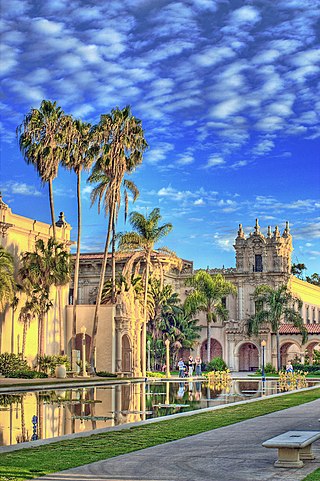
The California Pacific International Exposition was an exposition held in San Diego, California, during May 29, 1935–November 11, 1935 and February 12, 1936–September 9, 1936. The exposition was held in Balboa Park, San Diego's large central urban park, which had also been the site of the earlier Panama–California Exposition in 1915.

The Starlight Bowl is an amphitheater in Balboa Park in San Diego, California. It was constructed for the 1935–1936 California Pacific International Exposition and seats 4,300. It was originally named the Ford Bowl, as Ford Motor Company sponsored outdoor concerts at the venue during the exposition by the Mormon Tabernacle Choir, the San Francisco Symphony, and other performers.

The San Diego Art Institute was a contemporary art museum with a focus on artists from the Southern California and Baja Norte region. It was founded in 1941 as the San Diego Business Men's Art Club. Its name was changed in 1950 to the San Diego Art Institute. In 1953, women were admitted for membership. It officially became a nonprofit in 1963. The San Diego Art Institute in Balboa Park and Lux Art Institute in Encinitas merged in September 2021 to become the Institute of Contemporary Art, San Diego, with each museum continuing to operate at its respective site.

Balboa Park is a 1,200-acre (490 ha) historic urban cultural park in San Diego, California. Placed in reserve in 1835, the park's site is one of the oldest in the United States dedicated to public recreational use. The park hosts various museums, theaters, restaurants, and the San Diego Zoo. It is managed and maintained by the Parks and Recreation Department of the City of San Diego.

Zoro Garden is a six-acre sunken garden in Balboa Park in San Diego, California. It is located between the Fleet Science Center and Casa de Balboa. The name refers to the Persian mystic Zoroaster.

The California Quadrangle, California Building, and California Tower are historic structures located in Balboa Park in San Diego, California. They were built for the 1915–16 Panama–California Exposition and served as the grand entry to the event. The buildings and courtyard were designed by architect Bertram Goodhue. They were added to the National Register of Historic Places on May 17, 1974. They now house the Museum of Us.

Big Open Skull is an outdoor 1966–1973 bronze sculpture by Jack Zajac, installed outside the San Diego Museum of Art in San Diego's Balboa Park, in the U.S. state of California.
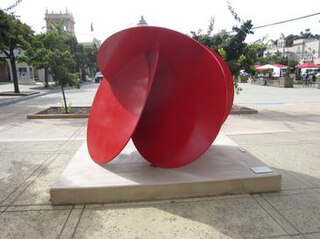
Odyssey III is an abstract 1973 painted aluminum sculpture by Tony Rosenthal, installed outside the San Diego Museum of Art in San Diego's Balboa Park, in the U.S. state of California.
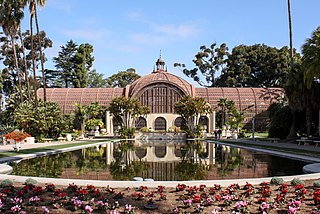
The Botanical Building is a historic building in Balboa Park in San Diego, California. Built for the 1915–16 Panama–California Exposition, it remains one of the largest lath structures in the world. Alfred D. Robinson (1867–1942), founder and president of the San Diego Floral Society, suggested the construction of a lath house as a feature of the Panama–California Exposition, which was to open in the City of San Diego on January 1, 1915.

The Spanish Village Art Center is an art center in Balboa Park in San Diego, California. Anni von Westrum Baldaugh was among the artists who had studio space at the Spanish Village. Current tenants include the San Diego Mineral and Gem Society and the Southern California Association of Camera Clubs.
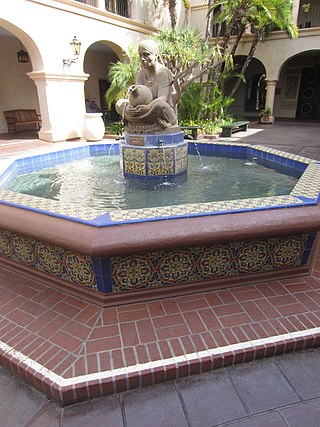
Woman of Tehuantepec, also known as Aztec Woman of Tehuantepec, is an outdoor 1935 fountain and sculpture by Donal Hord, installed in the courtyard of Balboa Park's House of Hospitality, in San Diego, California.
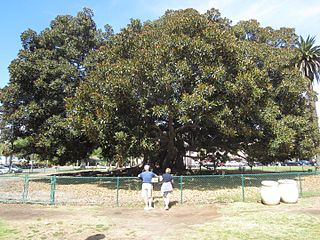
The Moreton Bay fig tree in San Diego's Balboa Park is one of the largest trees in California.

Bea Evenson Fountain is an outdoor fountain in San Diego's Balboa Park, in the U.S. state of California.
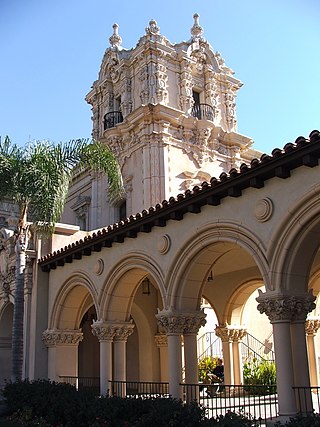
The Casa de Balboa is a building in Balboa Park in San Diego, California. The building was originally known as the Commerce and Industries Building, and later called the Canadian Building, the Palace of Better Housing, and the Electric Building. It is currently home to the Museum of Photographic Arts, San Diego History Center, San Diego Model Railroad Museum, and the Balboa Art Conservation Center.

Alcazar Garden is a formal garden in Balboa Park in San Diego, California. It is named for Alcazar Castle in Seville, Spain; its design is patterned after the castle's gardens.

The House of Hospitality is a building in Balboa Park in San Diego, California. It was originally built for the Panama–California Exposition (1915) as the Foreign Arts Building.

The Georgia Street Bridge in San Diego, California, was constructed in 1907 to carry traffic, after a streetcar line was cut through a ridge where Georgia Street stood. In 1914, a Romanesque spandrel arch with Mission Revival styling made of reinforced concrete and designed by J.R. Comly was built there.




















